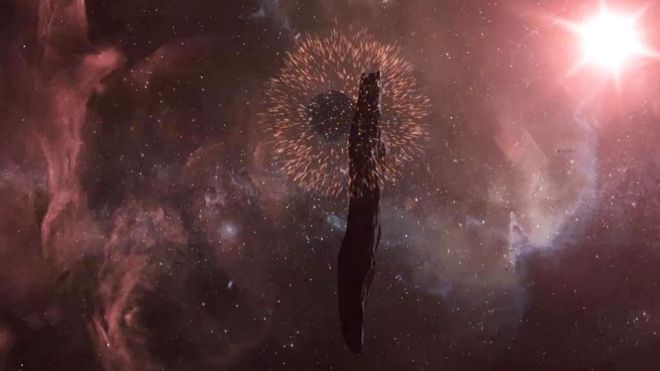That is the conclusion of new Belfast research that has examined in detail the light bouncing off the cigar-shaped asteroid from outside our Solar System.
"At some point or another it's been in a collision," says Dr Wes Fraser from Queen's University.
His team's latest study is featured in Sunday's Sky At Night episode on the BBC and published in Nature Astronomy.
It is yet another intriguing finding about this strange object that has fascinated scientists since its discovery back in October.
'Oumuamua comes from a different star system. Its path across the sky confirms it does not originate in our solar neighbourhood.
Initially, it was thought the object could be a comet, but it displays none of the classic behaviour expected of these cosmic wanderers - such as a dusty, water-ice particle tail.
'Oumuamua is in all likelihood an asteroid, albeit with a highly unusual shape. It has been described as resembling a cigar or cucumber, where the longest dimension is over 200m.
The Queen's team wanted to establish the exact nature and rate of the object's rotation.
To do this, the group studied variations in its brightness over time.
Almost immediately, Dr Fraser and colleagues could see that it was not spinning periodically like many small asteroids, but spinning chaotically - it was tumbling.
In Sunday's Sky At Night programme on BBC Four, the Queen's researcher illustrates this with the aid of a tennis table bat.
Throw it in the air one way and it will turn over evenly about a single axis; throw it up another way and it is possible to make the paddle turn over in an apparently haphazard way.
"It quickly starts to wobble around chaotically, and that's what we call tumbling," he tells presenter Chris Lintott.
The most probable explanation is that 'Oumuamua has been hit by another object at some point in its history.
The team can't say exactly when that happened but what they can say is that the tumbling will continue for at least a billion years.
"The tumbling actually causes stresses and strains internal to the object, and that slowly but surely squeezes and pulls on the object just like tides on the Earth to remove energy from the spin," explains Dr Fraser. This dampening process takes a very, very long time.
Dr Fraser says it is reasonable to assume the collision occurred in 'Oumuamua's own stellar system before it was then kicked out.
"It's hard to know if it was during planet formation or after the planet formation process," he tells Chris. "Certainly, more collisions happen while planets are growing than afterwards, so that’s a very good guess. But unfortunately we can’t get a high-resolution image of this thing to see what kind of crater is on it that might be attributed to the collision that caused it to start tumbling."
Image copyrightLSSTImage captionArtwork: The LSST should become operational in the next few years
The hunt is now on for more 'Oumuamua-like objects. Extrapolating from this one discovery, there ought to be some 10,000 of them passing through our Solar System inside the orbit of Neptune.
The trouble is - being so small and dark, they are extremely hard to spot.
There is though, a new observatory coming that may change this game completely. It is called the Large Synoptic Survey Telescope and it will come online in the next couple of years.
With its 8.4m primary mirror and super-digital camera, it will image the entire viewable sky from its position in Chile every few nights.
If anything is moving across the sky, it will be hard to escape the attention of the LSST.
"It is basically the perfect sort of tool to find objects like 'Oumuamua. We expect to find 100s of them with the LSST," Dr Fraser says.
BBC
More about: science
















































